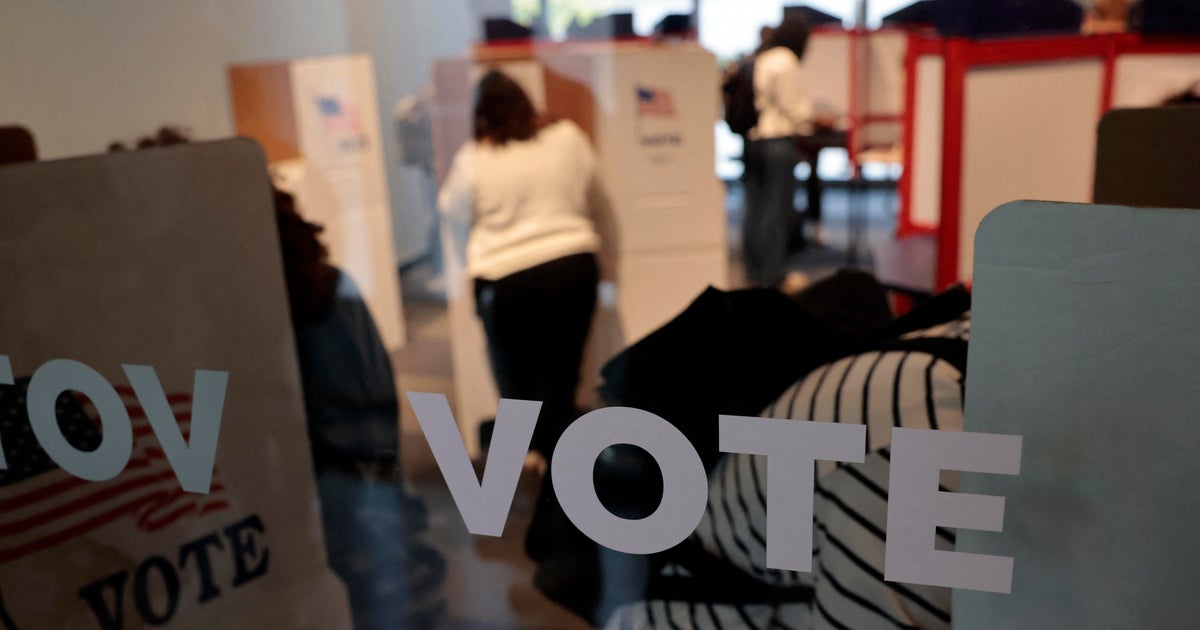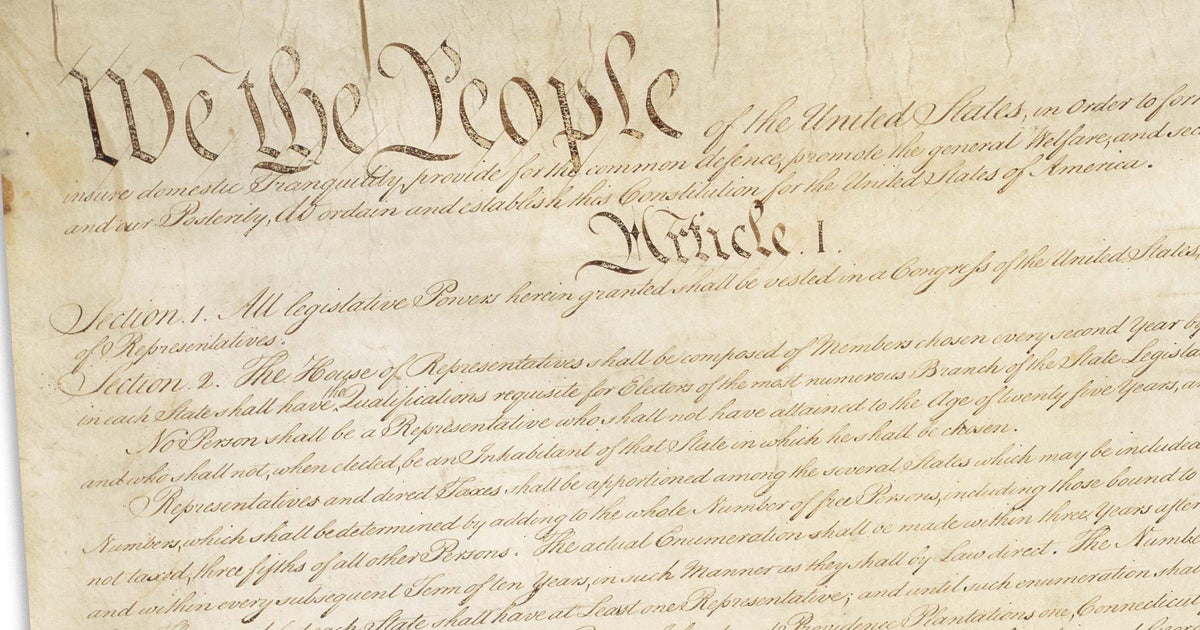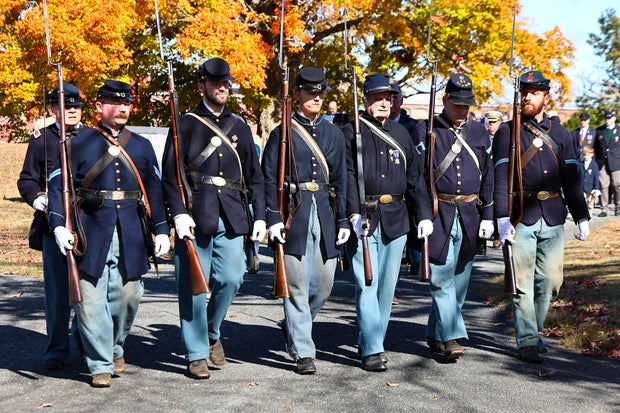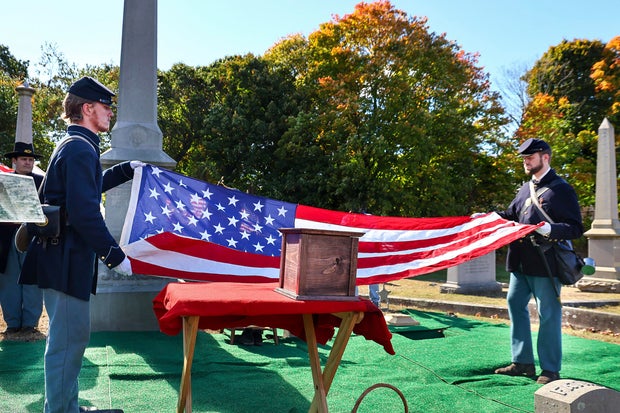CBS News
Here’s how much Donald Trump is worth, from his DJT stock to real estate

Donald Trump may have joined the ranks of America’s richest people through his real estate holdings, from golf courses to hotels, but it’s his stake in the fledgling Trump Media & Technology Group that has more than doubled his net worth to $5.5 billion this year.
The money-losing social media company, which trades under the ticker symbol DJT, the same as Trump’s initials, has had a volatile year since going public in March. An initial surge in the market value of Trump Media in March made the former president’s 57% stake worth $5.2 billion, but that tumbled to $1.4 billion when the stock hit a low of $11.75 in September.
The wild swings in Trump Media shares has prompted comparisons to meme stocks, or companies that trade on social media buzz rather than revenue or profit growth, investors’ favored yardsticks. Trump Media, whose main asset is the Truth Social platform, has declining revenue and large losses, with University of Florida finance professor Jay Ritter telling CBS MoneyWatch that the “stock is incredibly overvalued.”
Even so, Trump’s wealth dwarfs that of his rival, Vice President Kamala Harris, who with her husband, Douglas Emhoff, is worth about $8 million, according to an estimate by Forbes. Harris’ wealth stems from her decades in public service, book royalties and investments.
Here’s what to know about Trump’s wealth.
Trump’s DJT shares
Despite the roller coast in DJT shares, Trump’s stake in the social network has helped lift his overall net worth to $5.5 billion, more than double his $2.4 billion in wealth at the start of 2024, according to Forbes.
His stake in DJT shares, worth about $3.5 billion based on its November 1 closing price, remains his single largest financial asset. That’s down from $5.9 billion when the shares touched a recent high of $51.51 on October 29. Since then, DJT stock has shed half its value.
Because Trump has vowed not to sell any DJT shares, his stock market wealth for now remains largely on paper.
Where does Trump’s wealth come from?
Despite his billions in DJT stock, Trump’s original fortune stems from real estate, spanning residential buildings in New York City to golf courses and hotels around the globe.
Trump got his start working for his father, Fred Trump, a New York City real estate developer who built more than 27,000 apartments and row houses in Queens and Brooklyn, according to the New York Times. Trump claims his dad’s loan of $1 million helped him build his own business, which now includes holdings such as the Mar-a-Lago club in Florida and the Trump Tower in Manhattan.
One of his largest assets is his $500 million stake in 1290 Avenue of the Americas, an office building in Manhattan, while his Trump National Doral Miami Golf Resort is worth about $300 million, according to Bloomberg News.
Trump’s earnings from crypto, NFTs and Bibles
Trump also has received a financial boost from digital assets including cryptocurrencies and non-fungible tokens, or NFTs, an August financial disclosure form shows. The former president is also making money from licensing his name to a variety of objects, ranging from Bibles to sneakers.
Trump disclosed he earned $7.2 million in a NFT licensing deal, while he also has as much as $5 million locked up in a “virtual ethereum key.”
A $59.99 Bible that Trump endorsed in partnership with singer Lee Greenwood earned him $300,000 in royalties, while he booked $4.5 million for “Letters to Trump,” a 2023 collection of letters sent to Trump over the years from celebrities such as Oprah Winfrey.
The financial disclosure forms also show that Trump continues to earn money from the reality show “The Apprentice” and his 1987 book “The Art of the Deal.” He receives a pension from the Screen Actors Guild of more than $90,000 annually.
Despite the investments in crypto and NFTs, Trump’s investments are largely held in stocks, index funds and bonds, including U.S. Treasuries, according to the form. He also owns at least $100,000 in gold bars.
Trump’s liabilities
The disclosure forms, which are required of all presidential candidates, outlined liabilities including several mortgages on Trump Tower and other properties, as well as newer debts related to legal judgments.
Trump is appealing a trio of judgments against him for more than half a billion dollars. They include a combined $88.3 million from two cases in which juries found him liable for sexual abuse and defamation of the writer E. Jean Carroll, as well as a New York State case in which a judge ruled that Trump owes more than $450 million, including interest, for a fraud scheme. Trump has pledged millions in covering bonds in those cases.
CBS News
2 shot dead, 4 wounded by Mexico’s National Guard on migrant smuggling route near U.S. border

Mexico’s National Guard fatally shot two Colombians and wounded four others in what the Defense Department claimed was a confrontation near the U.S. border.
Colombia’s foreign ministry said in a statement Sunday that all of the victims were migrants who had been “caught in the crossfire.” It identified the dead as a 20-year-old man and a 37-year-old woman, and gave the number of Colombians wounded as five, not four. There was no immediate explanation for the discrepancy. The victims were identified by the foreign ministry as Yuli Vanessa Herrera Marulanda and Ronaldo Andrés Quintero Peñuelas.
Mexico’s Defense Department, which controls the National Guard, did not respond to requests for comment Monday on whether the victims were migrants, but it said one Colombian who was not injured in the shootings was turned over to immigration officials, suggesting they were.
If they were migrants, it would mark the second time in just over a month that military forces in Mexico have opened fire on and killed migrants.
On Oct. 1, the day President Claudia Sheinbaum took office, soldiers opened fire on a truck, killing six migrants in the southern state of Chiapas. An 11-year-old girl from Egypt, her 18-year-old sister and a 17-year-old boy from El Salvador died in that shooting, along with people from Peru and Honduras.
The most recent shootings happened Saturday on a dirt road near Tecate, east of Otay Mesa on the California border, that is frequently used by Mexican migrant smugglers, the department said in a statement late Sunday.
The Defense Department said a militarized National Guard patrol came under fire after spotting two vehicles — a gray pickup and a white SUV — in the area, which is near an informal border crossing and wind power generation plant known as La Rumorosa.
One truck sped off and escaped. The National Guard opened fire on the other truck, killing two Colombians and wounding four others. There was no immediate information on their conditions, and there were no reported casualties among the guardsmen involved.
One Colombian and one Mexican man were found and detained unharmed at the scene, and the departments said officers found a pistol and several magazines commonly used for assault rifles at the scene.
Colombians have sometimes been recruited as gunmen for Mexican drug cartels, which are also heavily involved in migrant smuggling. But the fact the survivor was turned over to immigration officials and that the Foreign Relations Department contacted the Colombian consulate suggests they were migrants.
Cartel gunmen sometimes escort or kidnap migrants as they travel to the U.S. border. One possible scenario was that armed migrant smugglers may have been in one or both of the trucks, but that the migrants were basically unarmed bystanders.
The defense department said the three National Guard officers who opened fire have been taken off duty while the incident is being investigated.
Former president Andrés Manuel López Obrador, who left office Sept. 30, gave the military an unprecedentedly wide role in public life and law enforcement; he created the militarized Guard and used the combined military forces as the country’s main law enforcement agencies, supplanting police. The Guard has since been placed under the control of the army.
But critics say the military is not trained to do civilian law enforcement work. Moreover, lopsided death tolls in such confrontations – in which all the deaths and injuries occur on one side – raise suspicions among activists whether there really was a confrontation.
For example, the soldiers who opened fire in Chiapas – who have been detained pending charges – claimed they heard “detonations” prior to opening fire. There was no indication any weapons were found at the scene.
CBS News
Kenyan man convicted of plotting 9/11-style attack on U.S.

A Kenyan man was convicted Monday of plotting a 9/11-style attack on a U.S. building on behalf of the terrorist organization al-Shabab.
A federal jury in Manhattan found Cholo Abdi Abdullah guilty on all six counts he faced for conspiring to hijack an aircraft and slam it into a building, according to court records.
He’s due to be sentenced next March and faces a mandatory minimum of 20 years in prison.
Handout / Criminal Investigation and Detection Group
Abdullah represented himself during the trial, which opened last week. He declined to give an opening statement and did not actively participate in questioning witnesses.
In court papers filed ahead of the trial, prosecutors said Abdullah intended to “merely sit passively during the trial, not oppose the prosecution and whatever the outcome, he would accept the outcome because he does not believe that this is a legitimate system.”
Lawyers appointed to assist Abdullah in his self-defense didn’t respond to an email seeking comment Monday.
Federal prosecutors, who rested their case Thursday, said Abdullah plotted the attack for four years, undergoing extensive training in explosives and how to operate in secret and avoid detection.
He then moved to the Philippines in 2017 and began training as a commercial pilot.
Abdullah was almost finished with his two-year pilot training when he was arrested in 2019 on local charges.
He was transferred the following year to U.S. law enforcement authorities, who charged him with terrorism-related crimes.
Prosecutors said Abdullah also researched how to breach a cockpit door and information “about the tallest building in a major U.S. city” before he was caught.
The State Department in 2008 designated al-Shabab, which means “the youth” in Arabic, as a foreign terrorist organization. The militant group is an al Qaeda affiliate that has fought to establish an Islamic state in Somalia based on Shariah law.
CBS News
The remains of 28 Civil War soldiers were found in a funeral home’s storage. They’ve now been laid to rest.

For several decades, the cremated remains of more than two dozen American Civil War veterans languished in storage facilities at a funeral home and cemetery in Seattle.
The simple copper and cardboard urns gathering dust on shelves only had the name of each of the 28 soldiers – but nothing linking them to the Civil War. Still, that was enough for an organization dedicated to locating, identifying and interring the remains of unclaimed veterans to conclude over several years that they were all Union soldiers deserving of a burial service with military honors.
“It’s amazing that they were still there and we found them,” said Tom Keating, the Washington state coordinator for the Missing In America Project, which turned to a team of volunteers to confirm their war service through genealogical research. “It’s something long overdue. These people have been waiting a long time for a burial.”
Most of the veterans were buried in August at Washington’s Tahoma National Cemetery.
In a traditional service offered to Civil War veterans, the historical 4th U.S. Infantry Regiment dressed in Union uniforms fired musket volleys and the crowd sang “The Battle Hymn of the Republic.” Names were called out for each veteran and their unit before their remains were brought forward and stories were shared about their exploits. Then, they were buried.
Among them was a veteran held at a Confederate prison known as Andersonville. Several were wounded in combat and others fought in critical battles including Gettysburg, Stones River and the Atlanta campaign. One man survived being shot thanks to his pocket watch – which he kept until his death – and another deserted the Confederate Army and joined the Union forces.
“It was something, just the finality of it all,” Keating said, adding they were unable to find any living descendants of the veterans.
While some remains are hidden away in funeral homes, others were found where they fell in battle or by Civil War re-enactors combing old graveyards.
Charles Lawrence / AP
Communities often turn reburials into major events, allowing residents to celebrate veterans and remember a long-forgotten war. In 2016, a volunteer motorcycle group escorted the remains of one veteran cross country from Oregon to the final resting place in Maine. In South Carolina, the remains of 21 Confederate soldiers recovered from forgotten graves beneath the stands of a military college’s football stadium were reburied in 2005.
Sometimes reburials spark controversy. The discovery of the remains of two soldiers from the Manassas National Battlefield in Virginia prompted an unsuccessful attempt in 2018 by several families to have DNA tests done on them. The Army rejected that request and reburied them as unknown soldiers at Arlington National Cemetery.
Along with those buried at Tahoma, Keating said, several others will be buried at Washington State Veterans Cemetery and a Navy veteran will be buried at sea. The remains of several more Civil War veterans were sent to Maine, Rhode Island and other places where family connections were found.
“Would have been lost to history”
Among them was Byron Johnson. Born in Pawtucket in 1844, he enlisted at 18 and served as a hospital steward with the Union Army. He moved out West after the war and died in Seattle in 1913. After his remains were delivered to Pawtucket City Hall, he was buried with military honors at his family’s plot in Oak Grove Cemetery.
Pawtucket Mayor Donald R. Grebien said Johnson’s burial service was the right thing to do.
“When you have somebody who served in a war but especially this war, we want to honor them,” he said. “It became more intriguing when you think this individual was left out there and not buried in his own community.”
Grebien said the burials recall important lessons about the 1861-1865 war to preserve the Union, fought between the North’s Union Army and the Confederate States of America at a cost of hundreds of thousands of lives.
“It was important to remind people not only in Pawtucket but the state of Rhode Island and nationwide that we have people who sacrificed their lives for us and for a lot of the freedoms we have,” he said.
Bruce Frail and his son Ben – both long active in the Sons of Union Veterans of the Civil War – were on hand for service. Ben Frail was also a re-enactor at Johnson’s service, portraying a Union Army captain.
Charles Lawrence / AP
“It’s the best thing we can do for a veteran,” said Bruce Frail, a former commander-in-chief with the Sons of Union Veterans and state coordinator for Missing In America Project.
“The feeling that you get when you honor somebody in that way, it’s indescribable,” he said.
The Missing in America Project says it has identified the remains of over 7,000 veterans and has buried over 6,800 soldiers.
The task of piecing together Johnson’s life story was left to Amelia Boivin, the constituent liaison in the Pawtucket mayor’s office. A history buff, she recalled getting the call requesting the city take possession of his remains and bury them with his family. She got to work and Johnson’s story became the talk of City Hall.
She determined Johnson grew up in Pawtucket, had two sisters and a brother and worked as a druggist after the war. He left to make his fortune out West, first in San Francisco and eventually in Seattle, where he worked nearly up until his death. It doesn’t appear Johnson ever married or had children, and no living relatives were found.
“I felt like it was resolution of sorts,” Boivin said. “It felt like we were doing right for someone who otherwise would have been lost to history.”
Earlier this year, two Union soldiers were posthumously honored by President Biden with the Medal of Honor for their courage in the “Great Locomotive Chase,” in which they went deep behind Confederate lines and stole a train in Marietta, Georgia. They ran the train north, tearing up tracks and cutting telegraph wires as they went.











